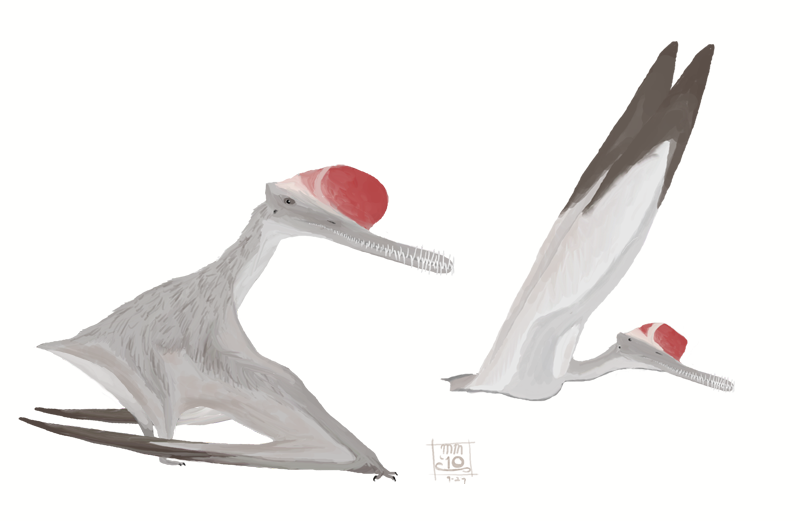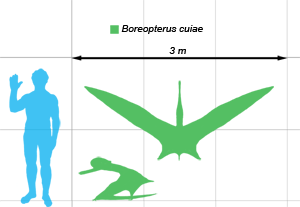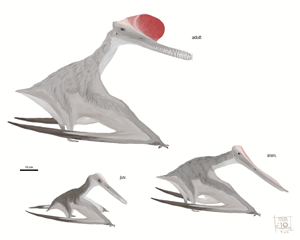home > natural history
Boreopterus cuiae
"Cui's northern wing"

Three specimens have been assigned to the family Boreopteridae, all from the lower Yixian formation of Liaoning. However, all three probably represent growth stages of a single species, Boreopterus cuiae. Thefield guide image (below right) depicts, from top to bottom, adult (Zhenyuanopterus longirostris Lu 2010), immature (Feilongus youngi Wang et al. 2005), and juvenile (Boreopterus cuiae Lu & Ji 2005) specimens. The last was named several months before Feilongus, so it will be considered the senior synonym if they're all proven to be conspecific. All three specimens are very similar and pterosaur researcher David Unwin considers them all to be growth stages of one species.
Boreopterus is a member of the Ornithocheiroidea, probably Ornithocheridae itself. I gave them all larger crests than the're preserved with, especially the adult form. Several fossils show that even in pterosaur species with only very small bony ridges on their skulls, the crests can extend very, very high from the skull, with the bone only forming the very base. The remainder of the crests are composed of a keratin-like substance made of spiral, rigid epidermal structures. Research has shown that these huge soft tissue crests are so widespread amongst both rhaphorhynchoid-grade and pterodactyloid pterosaurs, that it's probable all pterosaurs had large crests, regardless of whether or not they show bony support.
In many pterosaurs, Boreopterus included, one of the most dramatic changes throught the life history of individuals is the increase in size and number of teeth. In the juvenile, the teeth are relatively small and resticted to the front half of the jaws. By adulthood, however, the teeth extend the length of the jaws nearly to their joint, with the front teeth growing extremely long. This probably reflects niche partitioning between adults and juveniles. Unlike most birds, most pterosaurs took several years to grow to adult size. At any given time, a population of pterosaurs would include both fully grown adults, juveniles, and young flaplings, all having to compete for food and resources. The differences in their dentition shows that this intra-species competition was limited, because the diet and feeding style of adults and juveniles differed and that, ecologically, they functioned as distinct species. The teeth of the juveniles is similar to pterosaurs like Pterodactylus, and they probably lived on sandy lakeside beaches or muddy riverbanks probing for crustaceans, or feeding on insects in the large trees of the Jehol forests. Adults, on the other hand, have teeth perfectly suited for a diet of fish. Ornithocheirids are more specialized for flying than many other pterosaurs, with very long wings and tiny feet with slender hind limbs ill suited for walking. Adults were possibly dip-feeders, plucking fish from near the surface of lakes, rarely coming to rest on rocky outcrops or in trees, which they could cling to with their large wing claws. The feet of the juveniles are just as small as the adults, so they may have preferred probing for insects in trees or catching them on the wing, rather than on the ground like their sturdier-footed cousins.
.
Image Details:
Media: Digital, Adobe Photoshop CS3 with WACOM Graphire 3
License: ALL RIGHTS RESERVED
DESCRIPTION
Length: m (ft)
Weight: kg (lbs)
Location: Yixian Formation, Liaoning, China
Time: Aptian age, Early Cretaceous (125ma)
CLASSIFICATION
Kingdom: Animalia
Phylum: Chordata
Class: Stem-Aves
Order: Pterosauria
Family: Ornithocheiridae
Genus: Boreopterus
Species: B. cuiae
SYSTEMATICS
Sauropsida
Diapsida
Archosauria
Ornithosuchia
Pterosauria
Ornithocheiroidea
Ornithocheiridae

